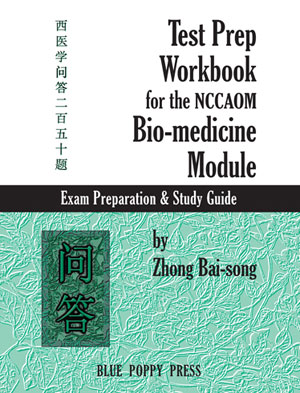Acupuncture and TCM Books
Test Prep Workbook for the NCCAOM Bio-medicine Module
 Test Prep Workbook for the NCCAOM Bio-medicine Module
Test Prep Workbook for the NCCAOM Bio-medicine Module
Check New and Used Prices
by Zhong Bai-song
This book is designed as a guide for the practitioner interested in taking the Bio-medicine portion of the NCCAOM exam. The NCCAOM Bio-medicine module is made up of 50 questions divided into three sections and this book is modeled after this exam, containing questions from each of the three categories. The book is divided into five tests containing 50 questions each. Each test includes an answer sheet, answer key and detailed explanations for most questions. Practitioners not interested in taking the Bio-medicine portion of the NCCAOM exam may also find the information contained in this book useful in their everyday clinical practice.
Sample Questions
1. The main symptoms of hepatitis B are:
A. renal colic, tinnitus, and dyspnea
B. chills, fever, nausea, vomiting, and malaise
C. edema, weight lost, distended abdomen, and constipation
D. severe cough, sore throat, and swollen lymph glands
2. In regard to the definition of antisepsis, which one of the following is the best description?
A. The use of chemicals and procedures designed to destroy or reduce the number of
pathogens on inanimate objects.
B. The use of procedures that destroy all microbial life, including viruses.
C. Products designed to reduce microbial life on living tissue, particularly on the skin of the
patient or practitioner.
D. The introduction of disease-causing organisms into or onto previously clean or sterile
objects, making them impure.
3. Which of the following is NOT an action of cortisone?
A. Reduce inflammation.
B. Decrease edema of inflammation.
C. Reduce pain by inhibiting some pain-causing molecules called prostaglandins.
D. Treatment of Cushing´s syndrome.
4. Absorption of nutrients mainly occurs in:
A. stomach
B. small intestine
C. large intestine
D. rectum
5. Which of the following organs is influenced by the sympathetic nervous system?
A. urinary bladder
B. gastrointestinal tract
C. pupils of the eyes
D. heart
E. All of the above
6. All of the following substances or cell components cannot usually be found in a mature red
blood cell EXCEPT:
A. mitochondria
B. hemoglobin
C. nucleus
D. lysosome
7. Which of the following is among the highest risk factor for breast cancer in women?
A. early menopause
B. low-fat, high-fiber diet
C. history of ovarian cancer
D. history of using birth control pills
8. Which one of the following is a true statement about treatment of cancer pain?
A. Identifying the cause of the pain is not included in palliative care.
B. The confusion and drowsiness of a narcotic analgesic can be treated by switching to
another narcotic analgesic.
C. Intractable, chemotherapy-caused nausea and vomiting can be managed by a
serotonin antagonist.
D. Fear and anxiety modify pain threshold without affecting its management.
9. All of the following organisms causes diarrhea EXCEPT:
A. neisseria gonorrhoeae
B. clostridium perfringens
C. escherichia coli
D. vibrio cholerae
E. giardia lambria
10. Which of the following most likely causes diarrhea to a patient on antibiotics?
A. escherichia coli
B. streptococcus faecalis
C. bacteroides fragilis
D. clostridium difficile
11. Cushing´s syndrome is characterized by all of the following signs EXCEPT:
A. hyperpigmentation of the skin
B. acne
C. weight gain
D. hypertension
12. As part of the routine in your practice, you measure the blood pressure of each patient. In
regard to blood pressure measurement, which of the following is true?
A. A cuff that is too narrow will measure an artificially low reading.
B. Blood pressure readings from both arms are always equal.
C. The measurement can be done any moment during the visit.
D. The width of the bladder should cover entirely the circumference of the arms.
E. It is necessary to fully deflate the cuff before repeating a measurement.
13. A 45-year-old female patient, 5 ft tall, weighing 140 lbs, presents to you acute, steady right
upper quadrant pain of the abdomen. This pain aggravates with fatty food, and is accompanied
by pain and nausea. She looks a little jaundiced. On further examination, she is slightly
febrile, and her right costal margin is tender on deep palpation. Her pulse feels slippery and
strong, and her tongue looks red with greasy yellow coating. The most possible diagnosis is:
A. acute pancreatitis
B. peptic ulcer disease
C. acute appendicitis
D. acute cholecystitis
Test Prep Workbook for the NCCAOM Bio-medicine Module
Check New and Used Prices